Impact of Heat Pump and Cogeneration Integration on Power Distribution Grids Based on Transition Scenarios for Heating in Urban Areas
Abstract
1. Introduction
2. Methodology
2.1. Definition of Boundaries
- Temporal
- Spatial
- 1.
- finding all existing subgraphs (sg)
- 2.
- finding all transformers in sg
- 3.
- if amount of transformers in sg > 1:
- 3a.
- determine distance between all transformer nodes in sg
- 3b.
- find pair of connected transformator nodes with the shortest distance
- 3c.
- determine and cut edge located in the middle of both nodes
- 3d.
- return to 3.
- 4.
- else:
- 4a.
- return to 1 and check next subgraph sg + 1
- Data Pre-Processing
2.2. Creation of Initial Scenario (s0)
2.3. Future Scenarios
2.4. Power Flow Simulation
3. Results
3.1. Initial Scenario (s0)
3.2. Future Scenarios
3.3. Grid Reinforcement vs. Cogeneration
3.4. Voltage Regulation by Photovoltaic Systems
3.5. Impact on Initial Electricity Consumption k-Medoids Day
4. Discussion and Perspectives
5. Conclusions
Author Contributions
Funding
Data Availability Statement
Acknowledgments
Conflicts of Interest
References
- Rüdisüli, M.; Teske, S.L.; Elber, U. Impacts of an Increased Substitution of Fossil Energy Carriers with Electricity-Based Technologies on the Swiss Electricity System. Energies 2019, 12, 2339. [Google Scholar] [CrossRef]
- Rüdisüli, M.; Romano, E.; Eggimann, S.; Patel, M. Decarbonization strategies for Switzerland considering embedded greenhouse gas emissions in electricity imports. Energy Policy 2022, 162, 112794. [Google Scholar] [CrossRef]
- Yang, Y.; Javanroodi, K.; Nik, V.M. Climate Change and Renewable Energy Generation in Europe-Long-Term Impact Assessment on Solar and Wind Energy Using High-Resolution Future Climate Data and Considering Climate Uncertainties. Energies 2022, 15, 302. [Google Scholar] [CrossRef]
- Swiss Federal Office of Energy (SFOE). Energy-Perspectives-2050+. 2020. Available online: https://www.bfe.admin.ch/bfe/en/home/policy/energy-perspectives-2050-plus.html/ (accessed on 12 December 2022).
- Park, B.; Hur, J. Spatial prediction of renewable energy resources for reinforcing and expanding power grids. Energy 2018, 164, 757–772. [Google Scholar] [CrossRef]
- Brown, T.; Schlachtberger, D.; Kies, A.; Schramm, S.; Greiner, M. Synergies of sector coupling and transmission reinforcement in a cost-optimised, highly renewable European energy system. Energy 2018, 160, 720–739. [Google Scholar] [CrossRef]
- Fesefeldt, M.; Capezzali, M.; Bozorg, M.; de Lapparent, M. Evaluation of Future Scenarios for Gas Distribution Networks under Hypothesis of Decreasing Heat Demand in Urban Zones. Energy 2021, 231, 120909. [Google Scholar] [CrossRef]
- Jonin, B. Systèmes Décentralisés de Recharge des Véhicules Électriques et Application aux Futurs Microgrids de Quartier. Bachelor’s Thesis, School of Engineering and Management Vaud, HES-SO University of Applied Sciences and Arts Western Switzerland, Delémont, Switzerland, 2021. [Google Scholar]
- Group E. PT3—Critères D’accès aux Différents Niveaux de Tension Pour Clients Finaux. Technical Report, Groupe E SA. 2017. Available online: https://www.yumpu.com/fr/document/view/22091075/criteres-dacces-aux-differents-niveaux-de-tension-pour-groupe-e (accessed on 12 December 2022).
- Viteos. Prescriptions Techniques Relatives aux Conditions générales (CG) de Raccordement, D’utilisation du réseau et de Fourniture d’énergie électrique. Technical Report, Viteos SA. 2009. Available online: https://viteos.ch/wp-content/uploads/Prescription_05_01-07-2009.pdf (accessed on 12 December 2022).
- Thurner, L.; Scheidler, A.; Schäfer, F.; Menke, J.; Dollichon, J.; Meier, F.; Meinecke, S.; Braun, M. pandapower—An Open-Source Python Tool for Convenient Modeling, Analysis, and Optimization of Electric Power Systems. IEEE Trans. Power Syst. 2018, 33, 6510–6521. [Google Scholar] [CrossRef]
- Frank, S.; Sexauer, J.; Mohagheghi, S. Temperature-Dependent Power Flow. IEEE Trans. Power Syst. 2013, 28, 4007–4018. [Google Scholar] [CrossRef]
- Ngoko, B.; Sugihara, H.; Funaki, T. A Temperature Dependent Power Flow Model Considering Overhead Transmission Line Conductor Thermal Inertia Characteristics. In Proceedings of the 2019 IEEE International Conference on Environment and Electrical Engineering and 2019 IEEE Industrial and Commercial Power Systems Europe (EEEIC/I&CPS Europe), Genova, Italy, , 11–14 June 2019; pp. 1–6. [Google Scholar] [CrossRef]
- Glover, J.D.; Sarma, M.S.; Overbye, T.J. Power System Analysis and Design; Cengage Learning: Boston, MA, USA, 2008; Volume 4. [Google Scholar]
- Merai, M.; Naouar, M.; Slama-Belkhodja, I.; Monmasson, E. Grid connected converters as reactive power ancillary service providers: Technical analysis for minimum required DC-link voltage. Math. Comput. Simul. 2019, 158, 344–354. [Google Scholar] [CrossRef]
- Sal y Rosas, D.; Chavez, D.; Frey, D.; Ferrieux, J.P. Single-Stage Isolated and Bidirectional Three-Phase Series-Resonant AC–DC Converter: Modulation for Active and Reactive Power Control. Energies 2022, 15, 8070. [Google Scholar] [CrossRef]
- Crimmann, M.; Madlener, R. Assessing Local Power Generation Potentials of Photovoltaics, Engine Cogeneration, and Heat Pumps: The Case of a Major Swiss City. Energies 2021, 14, 5432. [Google Scholar] [CrossRef]
- Kisse, J.M.; Braun, M.; Letzgus, S.; Kneiske, T.M. A GIS-Based Planning Approach for Urban Power and Natural Gas Distribution Grids with Different Heat Pump Scenarios. Energies 2020, 13, 4052. [Google Scholar] [CrossRef]
- Wang, L.; Yan, R.; Saha, T.K. Voltage regulation challenges with unbalanced PV integration in low voltage distribution systems and the corresponding solution. Appl. Energy 2019, 256, 113927. [Google Scholar] [CrossRef]
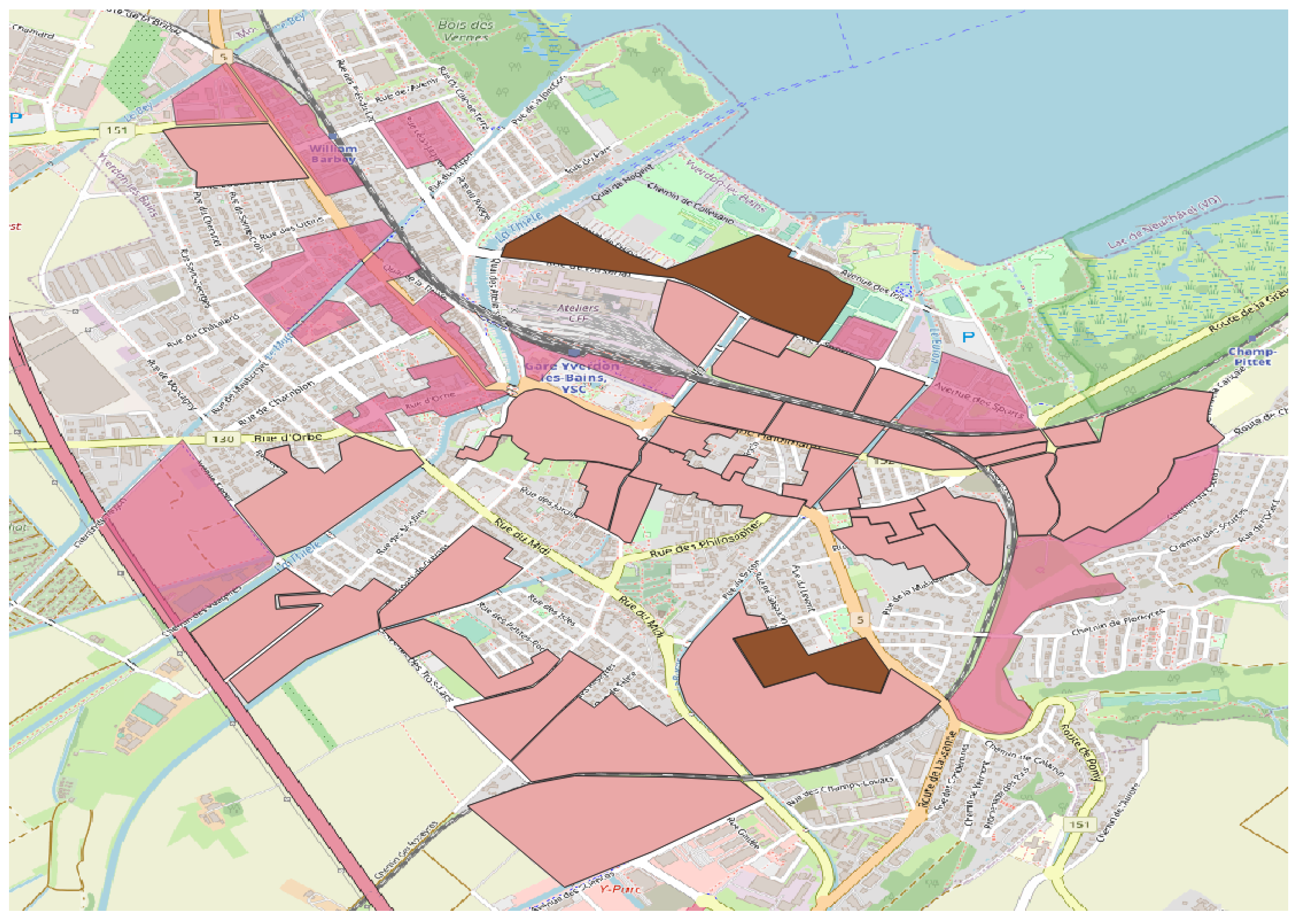

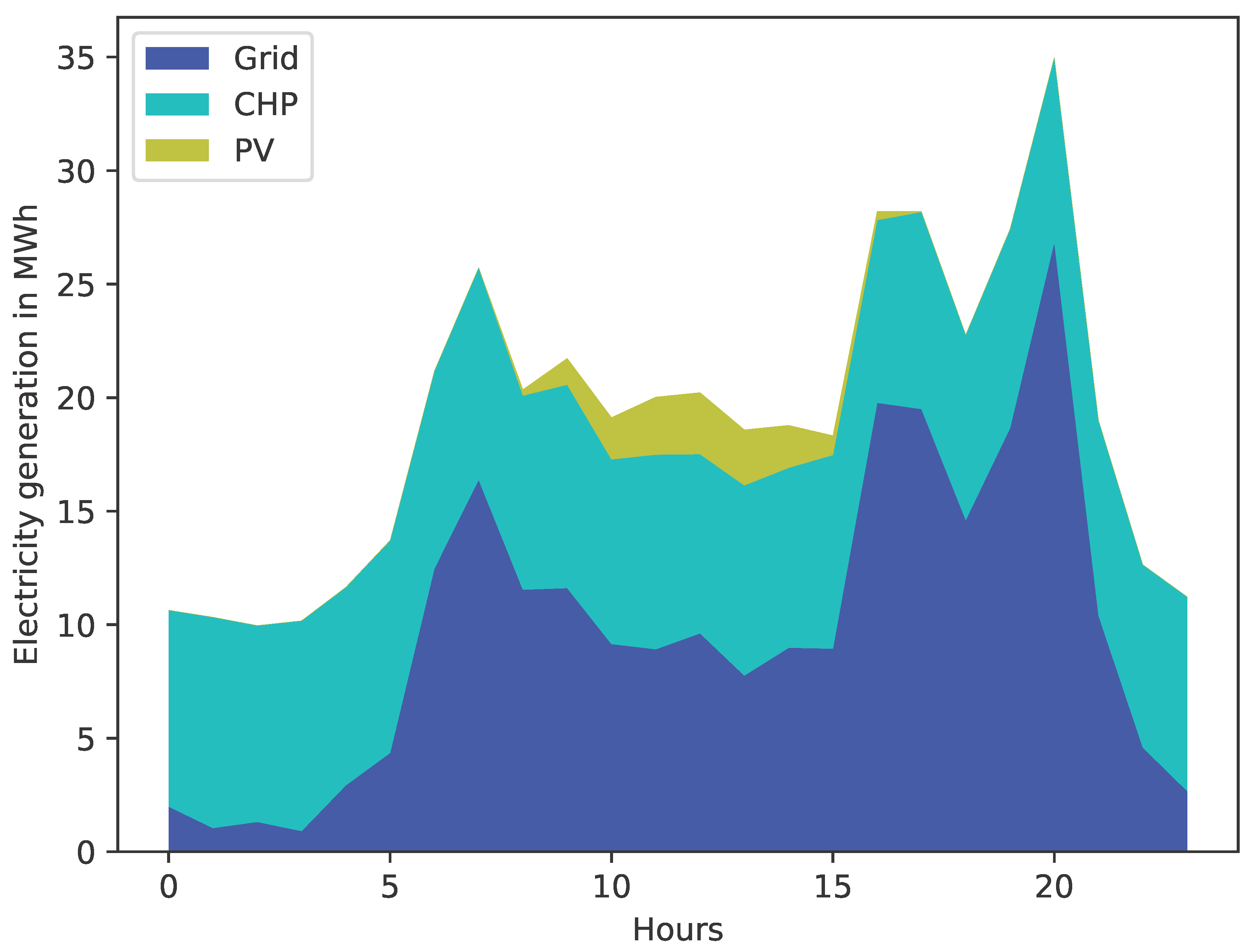
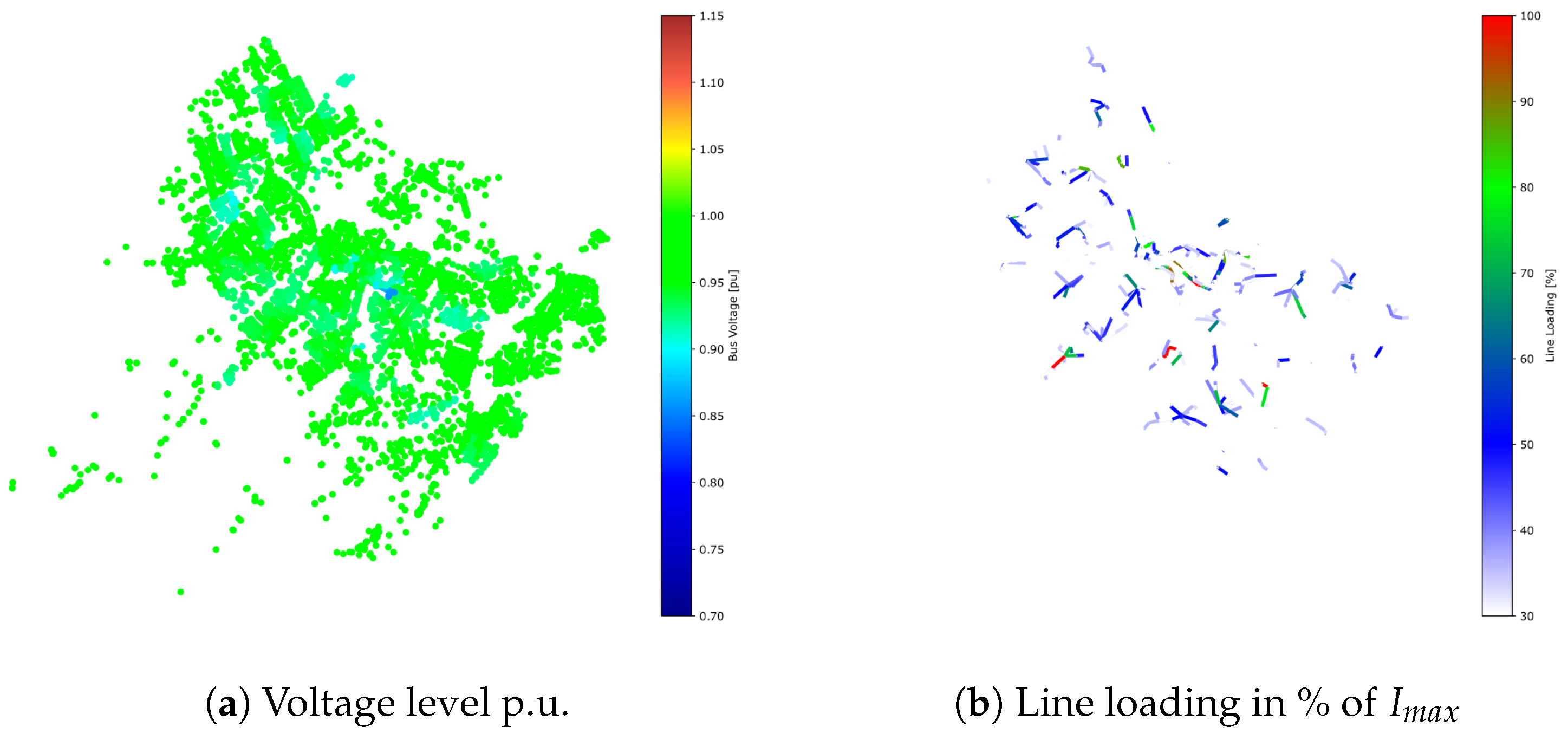


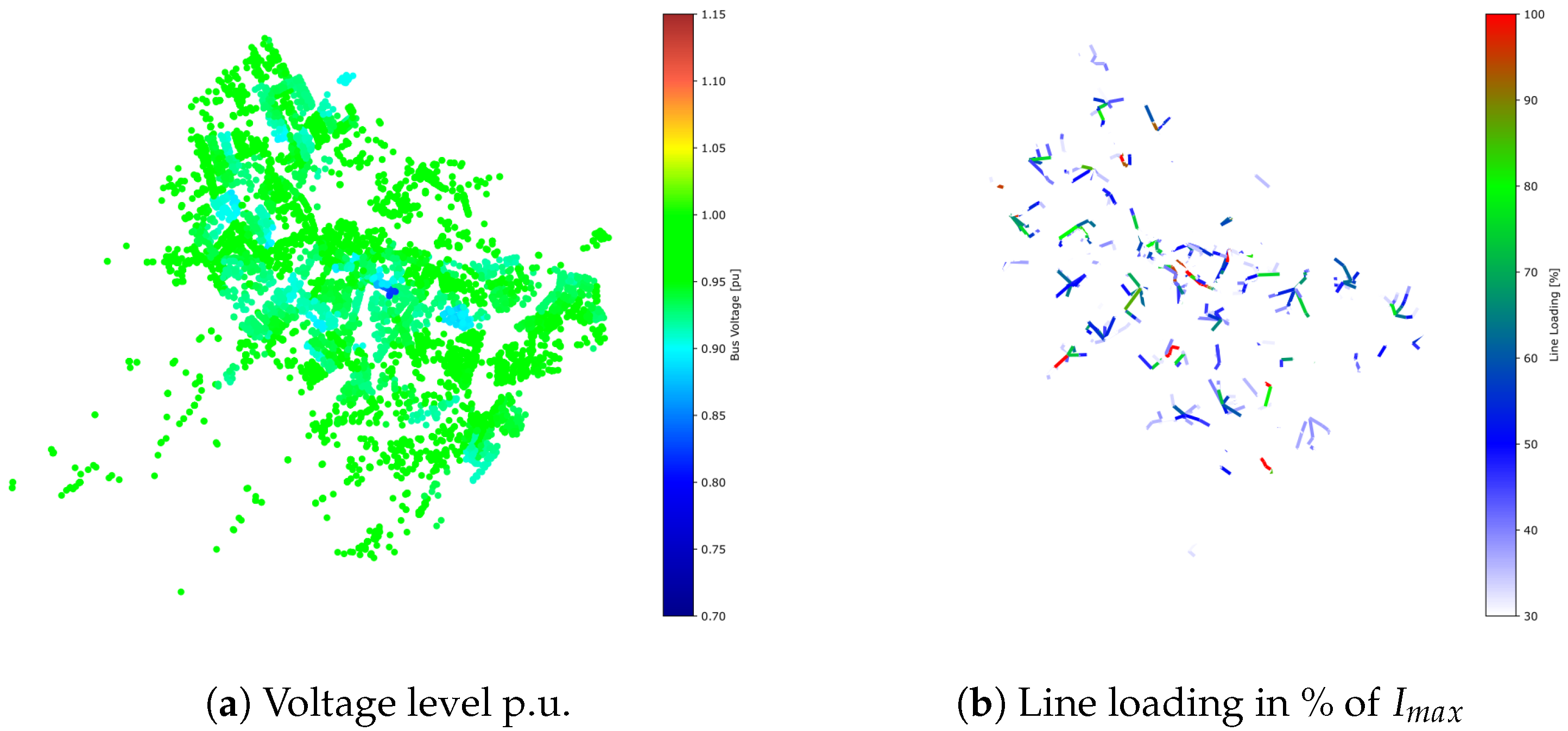
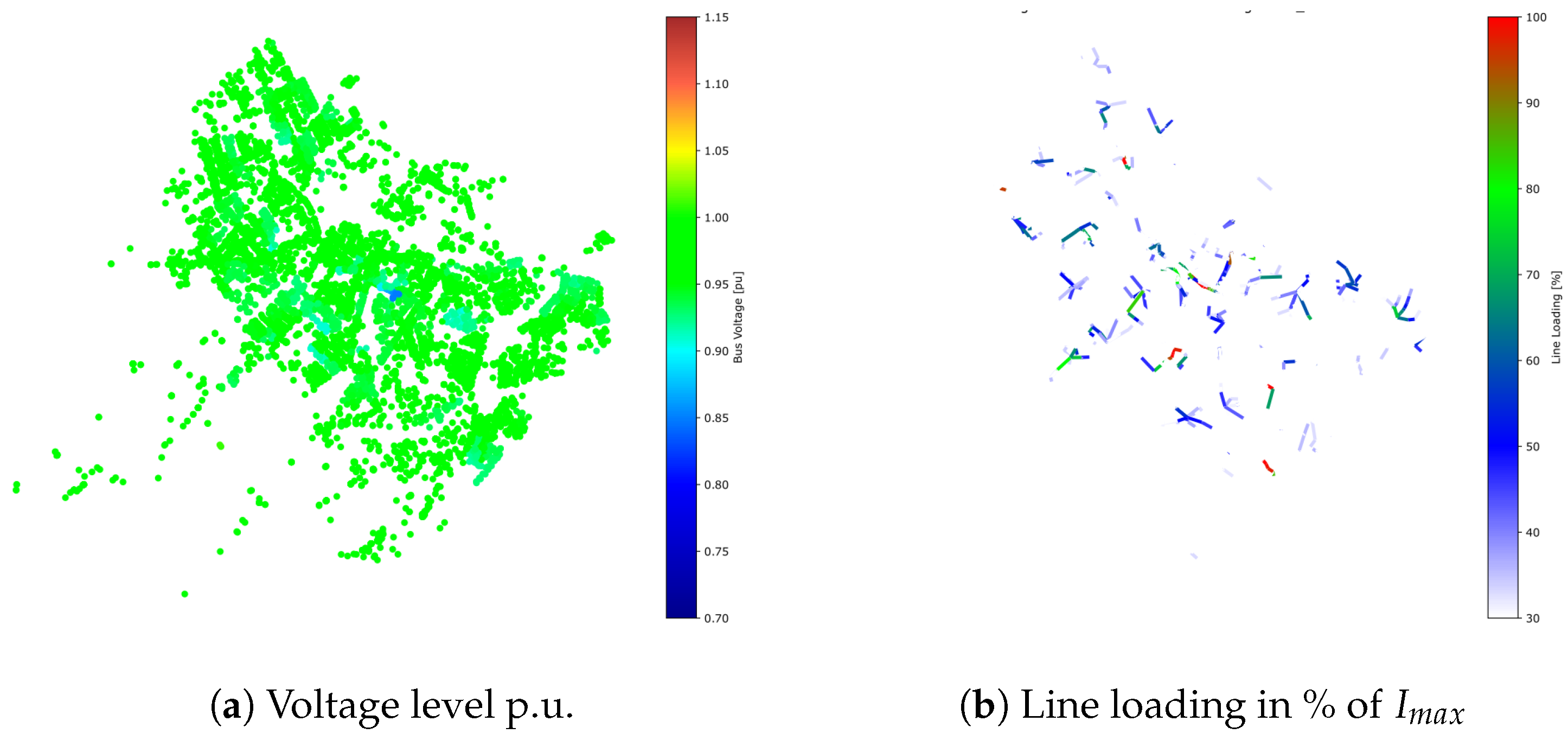

| Transition from… to… | Oil Boiler | Gas Boiler | DHN | HP | CHP |
|---|---|---|---|---|---|
| Scenario 0 | - | - | - | - | - |
| Scenario 1 | HP | HP | future * | - | HP |
| Scenario 2 | HP | - | future * | - | - |
| Scenario 3 | HP | CHP | future * | - | - |
| Parameter | Value | Unit |
|---|---|---|
| Surface of YLB | 13.54 | km |
| Inhabitants | 29,955 | - |
| Number of Buildings | 3364 | - |
| Nodes | 9744 | - |
| Length LV cables | 270.32 | km |
| Length MV cables | 53.95 | km |
| Transformers | 85 | - |
| Technology | Parameter | s0 | s1 | s2 | s3 |
|---|---|---|---|---|---|
| Oil Boiler | # Buildings | 1118 | - | - | - |
| % | 35.9 | - | - | - | |
| Gas Boiler | # Buildings | 2208 | - | 2150 | - |
| % | 61.8 | - | 42.3 | - | |
| DHN | # Buildings | 3 | 105 | 105 | 105 |
| % | 0.6 | 31 | 31 | 31 | |
| HP | # Buildings | 35 | 3259 | 1109 (+6) | 1109 |
| % | 0.8 | 69 | 25.3 | 25.3 | |
| CHP | # Buildings | - | - | - (+1) | 2150 |
| % | - | - | - | 42.3 |
| 100% Cable Resistance | Iter. 1 (80%) | Iter. 2 (64%) | ||||
|---|---|---|---|---|---|---|
| Scenario | s0 | s1 | s2 | s3 | s1 | s1 |
| V ≤ 0.9 p.u. (Nodes) | 64 | 993 | 263 | 60 | 657 | 481 |
| V ≤ 0.85 p.u. (Nodes) | 0 | 85 | 43 | 20 | 43 | 23 |
| LL ≥ 80% (in km) | 1.66 | 8.75 | 3.26 | 1.69 | 3.21 | 1.28 |
| LL ≥ 100% (in km) | 0.67 | 3.20 | 1.13 | 0.49 | 1.26 | 0.07 |
| LL ≥ 150% (in km) | 0 | 0.39 | <0.01 | 0 | <0.01 | 0 |
| 100% Cable Resistance | Iter. 1 (80%) | Iter. 2 (64%) | ||||||||
|---|---|---|---|---|---|---|---|---|---|---|
| Scenario | ||||||||||
| V ≤ 0.9 p.u. | 993 | 389 | 136 | 50 | 239 | 51 | 29 | 190 | 34 | 0 |
| V ≤ 0.85 p.u. | 85 | 43 | 21 | 0 | 24 | 0 | 0 | 0 | 0 | 0 |
| LL ≥ 80%(in km) | 8.75 | 8.32 | 9.83 | 11.95 | 3.42 | 4.65 | 7.28 | 1.48 | 3.16 | 5.15 |
| LL ≥ 100%(in km) | 3.20 | 3.38 | 3.61 | 4.74 | 1.35 | 1.92 | 2.55 | 0.16 | 0.75 | 1.49 |
| LL ≥ 150% (in km) | 0.39 | 0.20 | 0.71 | 0.92 | <0.01 | 0.25 | 0.54 | 0 | 0.23 | 0.37 |
| Scenario | s0 | s1 | s2 | s3 |
|---|---|---|---|---|
| V ≥ 1.1 p.u. | 0 | 117 | 125 | 126 |
| V ≤ 0.9 p.u. | 0 | 185 | 185 | 185 |
| LL ≥ 80% (in km) | 0.32 | 2.22 | 2.22 | 2.39 |
| LL ≥ 100% (in km) | 0.18 | 1.46 | 1.46 | 1.46 |
| LL ≥ 150% (in km) | ≤ 0.01 | 0.67 | 0.67 | 0.67 |
Disclaimer/Publisher’s Note: The statements, opinions and data contained in all publications are solely those of the individual author(s) and contributor(s) and not of MDPI and/or the editor(s). MDPI and/or the editor(s) disclaim responsibility for any injury to people or property resulting from any ideas, methods, instructions or products referred to in the content. |
© 2023 by the authors. Licensee MDPI, Basel, Switzerland. This article is an open access article distributed under the terms and conditions of the Creative Commons Attribution (CC BY) license (https://creativecommons.org/licenses/by/4.0/).
Share and Cite
Fesefeldt, M.; Capezzali, M.; Bozorg, M.; Karjalainen, R. Impact of Heat Pump and Cogeneration Integration on Power Distribution Grids Based on Transition Scenarios for Heating in Urban Areas. Sustainability 2023, 15, 4985. https://doi.org/10.3390/su15064985
Fesefeldt M, Capezzali M, Bozorg M, Karjalainen R. Impact of Heat Pump and Cogeneration Integration on Power Distribution Grids Based on Transition Scenarios for Heating in Urban Areas. Sustainability. 2023; 15(6):4985. https://doi.org/10.3390/su15064985
Chicago/Turabian StyleFesefeldt, Marten, Massimiliano Capezzali, Mokhtar Bozorg, and Riina Karjalainen. 2023. "Impact of Heat Pump and Cogeneration Integration on Power Distribution Grids Based on Transition Scenarios for Heating in Urban Areas" Sustainability 15, no. 6: 4985. https://doi.org/10.3390/su15064985
APA StyleFesefeldt, M., Capezzali, M., Bozorg, M., & Karjalainen, R. (2023). Impact of Heat Pump and Cogeneration Integration on Power Distribution Grids Based on Transition Scenarios for Heating in Urban Areas. Sustainability, 15(6), 4985. https://doi.org/10.3390/su15064985







